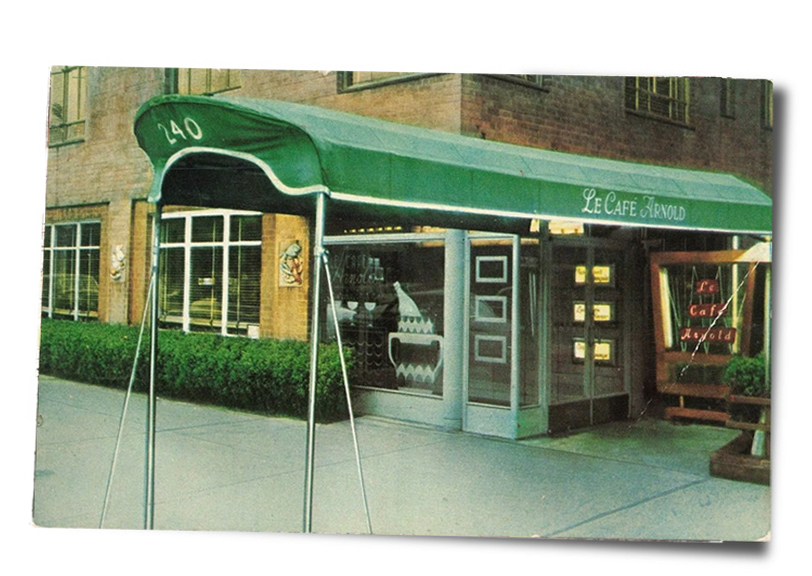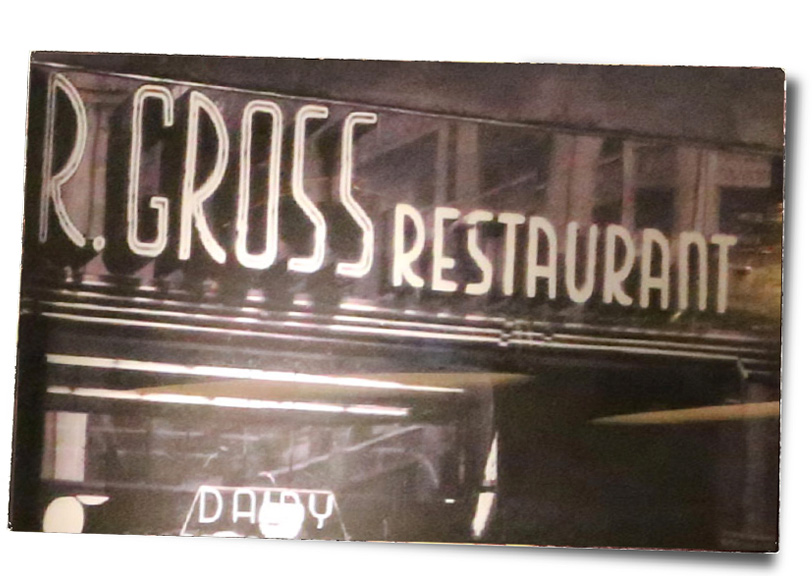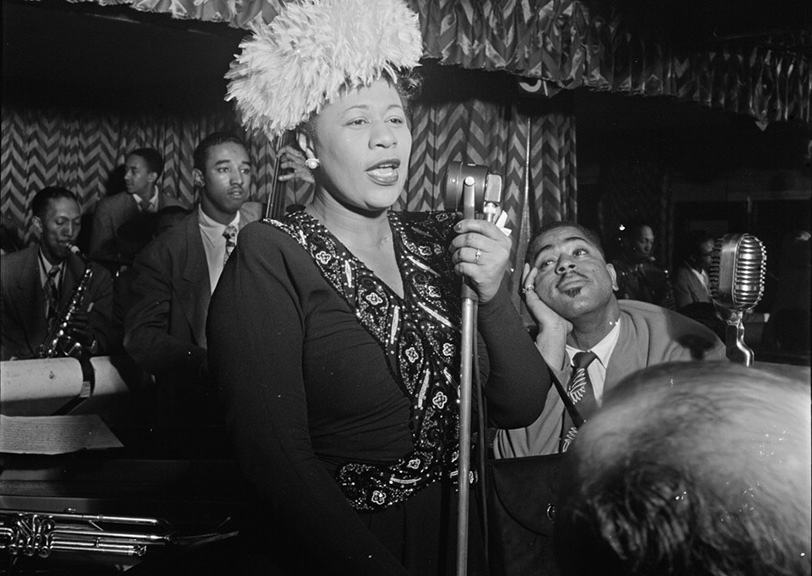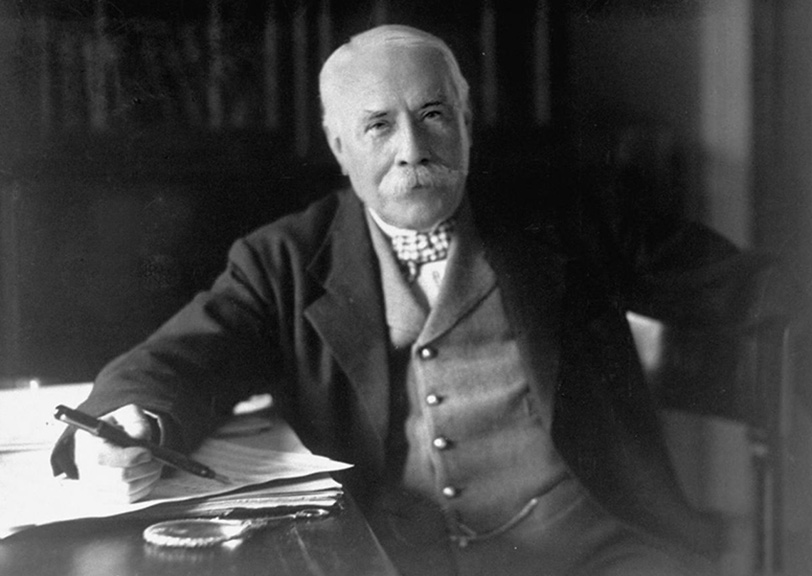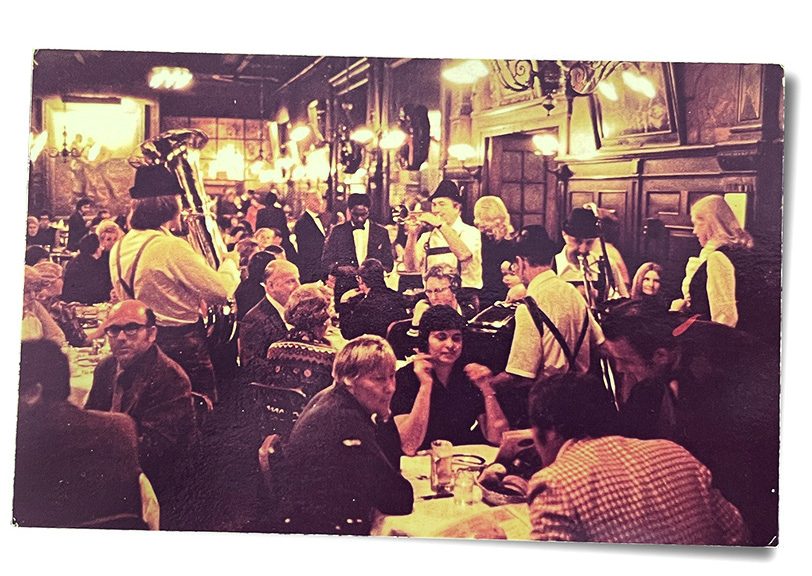ENTER YOUR EMAIL TO RECEIVE OUR WEEKLY NEWSLETTER
New York’s Changing Retail Scene
All those vacancies? Are they part of a paradigm shift? (Yes.) Will mom-and-pop shops survive or even re-open? (Some of them, yes. Rents are finally falling.)
By Linda Dyett
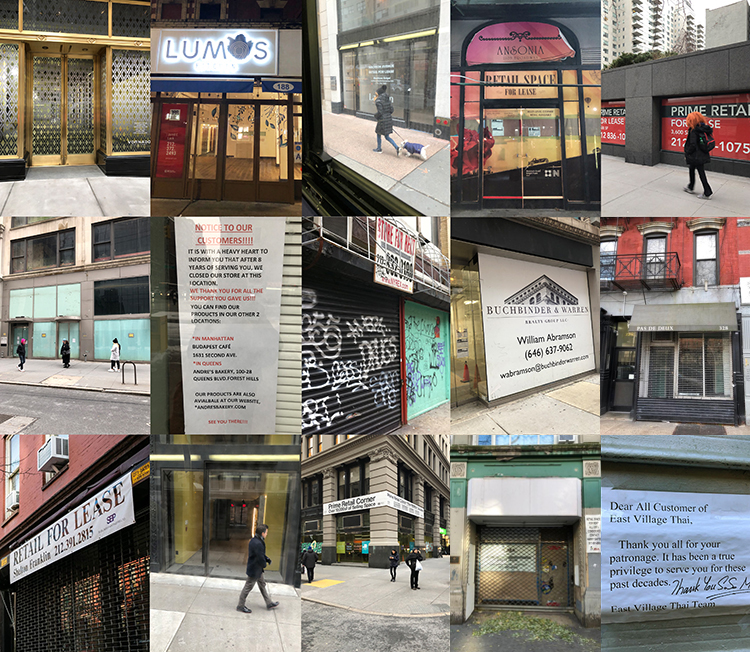
Take a look at New York’s retail scene (dispiriting as that may be). Vacant stores are everywhere. All those FOR RENT signs? They’re widely viewed as harbingers of an ominous future—and this in the city that set the pace for the modern world. Or is urban pacesetting in our past? Are we now acquiring the patina of history—like London and Paris—or turning into another Minneapolis?
According to the New York City Economic Development Corporation, we have the densest pool of consumers in the country. Yet in all five boroughs, but especially in Manhattan, the vacancies look apocalyptic. Swaths of the East Side have long-vacant, dust-filled storefronts. Block after block in Washington Heights, Harlem and El Barrio have multiple vacancies. Ditto Madison Avenue’s luxury zone and the bargain stores near Port Authority. In the East Village, 200 stores are reported closed. On one Avenue B block, everything is closed. On certain Greenwich Village streets, five or six in a row. Daniel J. O’Donnell, a State Assemblyman vying to become Public Advocate, points to “the bank-ization and drugstore-ization of the Upper West Side.” (But even some banks and drugstores are closing!) And in Midtown, both the Chrysler Building’s cavernous 42nd Street corner storefront and a substantial stretch of the Alcoa Building, right across the street, are tenant-less. I’m talking about vacancies at one of the world’s busiest urban intersections.
From the outset, ours has been a city of business titans, wheeler-dealers and strivers who sought out material goods to display their status—real or aspirational. We New Yorkers are shoppers, and we’ve been accommodated with a bonanza of retailers—many of which have closed. Think of our dear departed grand emporiums, Lord & Taylor’s demise being the most recent. Its Fifth Avenue building is being transformed into the global headquarters for that co-working behemoth WeWork. I, for one, have never recovered from the loss of Bonwit Teller and B. Altman. The landmarked Altman’s building has since served as the City University Graduate Center. As for the Bonwit’s building, it was demolished to make way for Trump Tower. (“That’s an omen, if I’ve ever heard one,” remarked the New York Times fashion director Vanessa Friedman in a recent article on department store closings.)
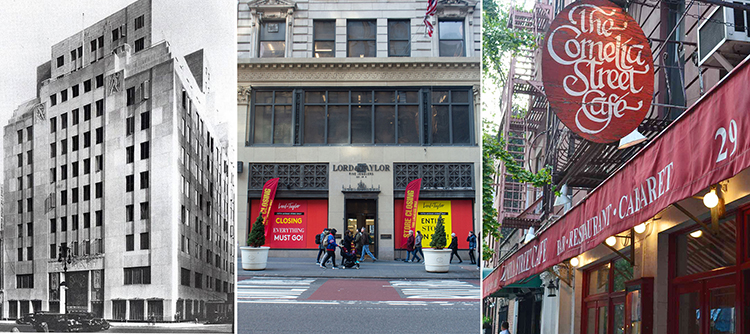
Bonwit Teller closed in 1979 and was replaced by Trump Tower in 1983; Lord & Taylor closed in 2018; Cornelia Street Cafe closed in 2019.
. . . . . . . . . . . .
Even more beloved in our walkable city are the independent, soul-satisfying mom-and-pop shops, bookstores, offbeat boutiques, restaurants and luncheonettes that arose in the 20th century. Will they survive? Amid what’s shaping up as a 21st century retail paradigm shift, these little spots now look like quaint relics. But they’re a large part of New York’s topography (and its allure)—and would benefit from public policies reflecting that fact.
Meanwhile, faced with astronomical rent increases, even the busiest of these retailers have been forced to move where the rent is lower: smaller spaces … basements … upper floors … deeper and deeper into Brooklyn. Or they permanently close. And no one experiences their loss more than those of us over age 50 or 60—in a city where many neighborhoods are now de facto senior citizen communities. Plenty of us still go shopping, only now we’re getting short shrift. As my feisty maiden aunt used to say, What am I? Chopped liver?
I’m all for change when it makes sense, and some of our newer retailers and restaurants suit New Yorkers to a T: Trader Joe’s; Uniqlo, the Japanese budget-priced clothing chain; Flying Tiger, for colorful $2 small-goods; Ole and Steen, the just-opened Danish eat-in bakery near Union Square, attracting multitudes; Dos Toros Taqueria, dishing out top-quality fast-casual Mexican fare (far tastier than Chipotle’s). Not to overlook native New York businesses like Shake Shack—founded in Madison Square Park; Jack’s Wife Freda, a friendly restaurant serving terrific cocktails, with three neighborhood branches; and Goods for the Study—an offshoot of McNally Jackson Books, selling hard-to-find writing materials. (Hey, even the merchandise there is an anachronism.)
“The Perfect Storm”
Robin Abrams, a retail expert who is vice chairman of Compass, the real estate brokerage, points to what she terms “a perfect storm” of two insidious problems that have plagued New York’s independent stores in recent years. Overly aggressive rents are one. Back as 2008, the Bleecker Street exotic antiques dealer Nusraty Afghan Imports saw its rent tripled, from $7,000 to $45,000. The owner, Abdul Nusraty, initially thought that was a joke. He moved to a smaller space, while the premises he occupied for 32 years were taken over by Brooks Brothers’ Black Fleece. That didn’t last. The space is now occupied by Accessorize—a mall chain. This fits a pattern. As noted by the Vanishing New York activist-blogger Jeremiah Moss: “[S]table, long-term small businesses get pushed out and then the space becomes unstable …”
The second culprit, e-commerce, is even more insidious. Rent hikes aren’t inevitable, but point-and-click shopping is an existential threat (our equivalent, you could say, of the Game of Thrones Night King’s army). It’s also “part of a larger story about the changing nature of the retailing landscape,” says Lynne Sagalyn, Professor Emerita of Real Estate at Columbia Business School. She adds, “I’m not sure that rent control, which seeks to freeze increases, would bring back the stores if the underlying driver is competition from online retailers.”
And yet … consumers today “are so trapped in [a] digital vortex that they’re craving some kind of experience beyond their phones,” says Brad Grossman, head of Zeitguide, a New York-based think tank for creative corporate leaders. Shoppers, he maintains, “still want to interact with a real-life person.”

Made By We, an “on-demand workspace,” event space, retail shop and cafe in the Flatiron District. Photo by Dave Burk.
. . . . . . . . . . . .
New Breeds of Retailers
And they do at Made By We—the huge, awkwardly named street level Flatiron District space its owner, WeWork, terms “a new town square.” Up front is a retail area selling member-made goods (skateboards … scooters). Further inside—an open zone with rent-for-a-half-hour-minimum work seats, as well as meeting rooms, café and lounge area. Multi-purpose work-shop-mingle-snack spaces like this may well occupy larger storefronts in the future. In fact, a couple of blocks south on Broadway, three busy restaurants are berthed in the newly downsized ABC Home.
Robin Abrams’ view is that “landlords who got overly aggressive created a difficult scenario that impacted the larger marketplace.” Now, as landlords finally awaken to the reality that few if any independent storekeepers are remotely able to afford skyrocketing rents, she sees “a rejigging of the retail real estate environment.” So instead of warehousing empty storefronts while awaiting tenants able to pay exorbitant rents, more and more landlords are inclined “to lock in deals at affordable rents … and more flexible, creative deal structures.” For instance, McNally Jackson’s original Nolita bookstore last year faced a 500K rent hike of $850,000. Plans were underway to move—until the rent got reduced to $650,000, with gradual increases over the next five years.
Landlords are also offering pop-up deals and short-term rentals to e-tailers testing their viability in brick-and-mortar stores. (This exemplifies a point Professor Sagalyn made in a phone interview: that “the lifecycles of stores are getting shorter and shorter.”) Viewing the retail blight that took hold on Bleecker Street over the past few years, the real estate company Brookfield Properties bought seven storefronts, assigning one-year leases and revenue shares to high-volume e-tailers (a vegan bodega, for example). “Having a physical store presence builds brand exposure,” Abrams says. “Brookfield is helping the community by putting in energetic new uses at below-market, bargain rents to reinvigorate a retail corridor.”
But while pop-ups and short-term rentals may be a boon for digital natives, it takes time for a new store to settle into a neighborhood. And what benefits do short-term rentals offer established shopkeepers facing rent hikes? None.

Soon-to-reopen Left Bank Books (photo by Michael Bucher). Newly reopened: midcentury home design dealer Area iD. Both businesses closed due to exorbitant rent hikes but are now resurfacing in new quarters, as landlords begin offering more reasonable rents.
. . . . . . . . . . . .
Meanwhile, a number of high-profile, highly successful online brands—1stdibs, TheRealReal, Warby Parker, One Kings Lane, Everlane, even Amazon—have moved long-term into brick-and-mortar premises. Such e-tail x retail mergers satisfy the urge to go out shopping—to touch the goods, try them on, compare sizes and styles in-person.
But far more satisfying is the return of retailers forced to close due to rent hikes. The antiques shop Area iD saw the rent at its Nolita store triple in 2015. It’s now relocated inside the vast new 1stdibs marketplace in West Chelsea; likewise, the Greenwich Village used and rare books dealer Left Bank Books, forced to close in 2016, is re-emerging in new quarters in March. Let’s hope these reboots, so to speak, become a trend.
Legalities
New York’s commercial rent legislation is a State issue, determined in Albany. In 1945, however, responding to a postwar demand for more storefront spaces, the State Senate granted New York City its own rent control laws. They expired in 1963, and since then—despite the radically changed retail climate—there’s been no new legislation, leaving shopkeepers with scant protections: no rights, for instance, to long-term lease renewals, no equal rights with landlords to negotiate new lease terms, no access to arbitration. And the Real Estate Board of New York, arguably the state’s most powerful, most indefatigable lobby, has blocked any such legislation ever since.
Alexander Urbelis, a partner in The Blackstone Group, a New York law firm, points to the new retail reality—evident in the massive storefront vacancies, and issues such as landlords misusing vacancies to apply for loans to leverage properties—as reasons for Albany to shoehorn in commercial rent legislation. It could possibly do so via authority granted to the New York City Council to pass laws regarding “health and welfare” issues. Arguably, Urbelis says, “the loss of tax revenue could be considered a matter of health and welfare.” As could reduced traffic to remaining stores in neighborhoods rife with vacancies. But getting such major legislation passed is a longshot, he allows. It would probably wind up in State Appellate Court, take years to be heard, and might not succeed.
One of the most historic of cities in the Western world, Rome, chock-full of legacy retailers, similarly has few shopkeeper protections And even though its city center is a UNESCO World Heritage Site, which limits the kind of businesses that can open there, it too has a number of empty storefronts.
Mayor de Blasio has vowed to lobby Albany for “a vacancy fee or a vacancy tax” on landlords making “an artificial attempt to jack up the rents by taking properties off the market.” Similarly, City Councilman Brad Lander proposes tax breaks for commercial landlords who offer affordable, long-term, renewable leases to independent small businesses. And State Senator Brad Hoylman, who represents parts of Midtown, Hell’s Kitchen and Greenwich Village, has proposed a wide range of policy measures, including creating a New York City Legacy Business Registry. You can read his recommendations in the PDF, Bleecker on Bleecker: A Snapshot of High-Rent Blight in Greenwich Village and Chelsea. New York City could also take measures like San Francisco’s stopgap funding for retailers in business 30 years or longer who need short-term financial assistance. And how about a registry of displaced legacy shopkeepers seeking new premises—and a city commission created to protect endangered legacy retailers?
Of course no one’s stopping landlords from offering flexible rental terms. “Rents are self-correcting,” proposes Robin Abrams. “It is cyclical, based on what the market will bear, competition for space, and supply and demand.”
As for our homegrown e-commerce-less little shops—like D.L. Cerney on an East Village side street, making and selling its own intricately designed 1930s-’60s-style men’s and women’s clothing: idiosyncratic retailers like this, with small but loyal customer bases, give New York its unique flavor.
Or as Alexander Urbelis puts it, “we can’t just back down when it comes to online retailers. Retail spaces keep New York quirky and interesting.” And fortunately, to our everlasting credit, we New Yorkers balk at malls—it’s in our civic DNA.

Lin-Manuel Miranda, of Hamilton fame, along with three partners, saved the Drama Book Shop from extinction when they bought the store. See the Drama Book Shop appeal here.
. . . . . . . . . . . .
What We Consumers Can Do—Five Suggestions
Curtail our online purchases and patronize local businesses. And keep in mind—plenty of neighborhood drugstores and groceries take phone and online orders and deliver. Let’s be loud about it and urge our neighbors to join us.
Become activists. Log onto these websites and blogs for news and specifics on taking action—where and how to protest and contact City Council members: SaveNYC.nyc, anhd.org (the Association for Neighborhood and Housing Development) and vanishingnewyork.blogspot.com.
Use social media to publicize stores near you facing sky-high rent hikes.
Take the crowdsourcing route and contribute your dollars to retailers in need. Westsider Books, on Upper Broadway, to cite one example, was saved from closing by exceeding its $50,000 crowdsourcing campaign. While financial crowdsourcing shouldn’t be relied on beyond stopgap funding, it’s a boon for saving stores from closing.
Those who have the wherewithal may be inspired to follow the lead of Lin-Manuel Miranda and three partners, who saved the Theatre District’s century-old Drama Book Shop from closing by buying and moving it to a new location. As for the shop’s 84-year-old longtime owner, Rozanne Seelen, she’ll be a consultant. Strength in numbers, readers!
. . . . . . . . . . . .
Reading Matter
To search for a local bookseller stocking a specific title or author, go indiebound.org, the website for a consortium of neighborhood bookshops.
Jane Jacobs, The Death and Life of Great American Cities (1992, Random House).
Roberta Brandes Gratz, The Living City: How America’s Cities Are Being Revitalized by Thinking Small in a Big Way (1994, Simon & Schuster).
James Howard Kunstler, The Geography of Nowhere: The Rise and Decline of America’s Man-Made Landscape (1994, Simon & Schuster).
Jeff Speck, Walkable City: How Downtown Can Save America, One Step at a Time (2012, Farrar, Straus and Giroux).
Jeremiah Moss, Vanishing New York: How a Great City Lost Its Soul (2017, Dey Street Books).
Samuel Stein, Capital City: Gentrification and the Real Estate State (Verso). Publication date: March 5.
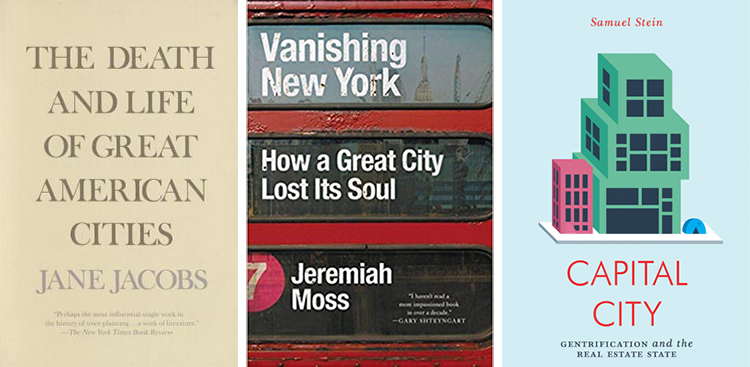
. . . . . . . . . . . .
Linda Dyett’s articles on fashion, beauty, health, home design, and architecture have appeared in The New York Times, Washington Post, Monocle, Afar, New York magazine, Allure, Travel & Leisure, and many other publications.
You may enjoy other NYCitywoman articles by Linda Dyett:
The Discreet Magic of Berets and Caps
New York Seniors and the Clutter Dilemma
Hair Style News: Isn’t it Time for an Update?
End-of-Winter Skin Soothers and Rechargers
The Latest in Makeup: Think Little or None
Tips from a Top NYC Hair Colorist
A Makeup Update for Mature Faces





